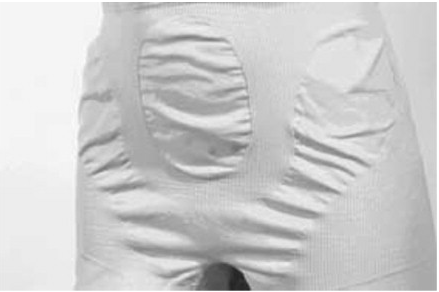Tubular fabrics
Tubular fabric is produced on a circular knitting machine. The threads run continuously around the fabric. Needles are arranged on the circular knitting machine. in a form of a circle and are knitted in the weft direction. There are four types of circular knitting – Run resistant circular knitting (aplicar, swimwear); Tuck stitch circular knit (used for underwear and outerwear); Ribbed circular knit (swimsuits, underwear and men’s under shirts); and Double knits and interlock. Many undergarments are made from tubular fabrics as it is fast and effective and requires very little finishing.
Traditionally, tubular fabrics have had a large application in the hosiery industry and still do. However, there has been a revolution in streamlined knitwear and there has been much innovation and re branding of this traditional fabric as ‘seamless’, which has helped to create a new demand. Figure 4.1shows a seamless undergarment. It has no side seams and it is knitted on a Santoni circular knitting machine. This type of product will increasingly replace cut-and-sew products as elasticity zones can be controlled, areas of single jersey can be built-in with three dimensions and ribbing can be incorporated. This can create shaping in the garment without any or with very little sewing required.
Textile Engineeations include underwering
The majority of weft knit fabrics are made on circular knitting machines. Of the two main weft knitting machines, a jersey machine is the most basic. Jersey items are typically referred to by the names circular knit and plain knit. Knitting needles are used to create the loops, and there is only one set on the jersey machine. Hosiery, T-shirts, and sweaters are examples of common materials.
A second set of needles, roughly at right angles to the set found in a jersey machine, is present on rib knitting machines. They are used to make fabrics using double knitting. In weft knits, different needle movements can be used to create tuck and miss stitches for texture and color patterns, respectively. Multiple yarns can be utilized in the manufacturing process in place of one yarn.
Post time: Feb-04-2023

